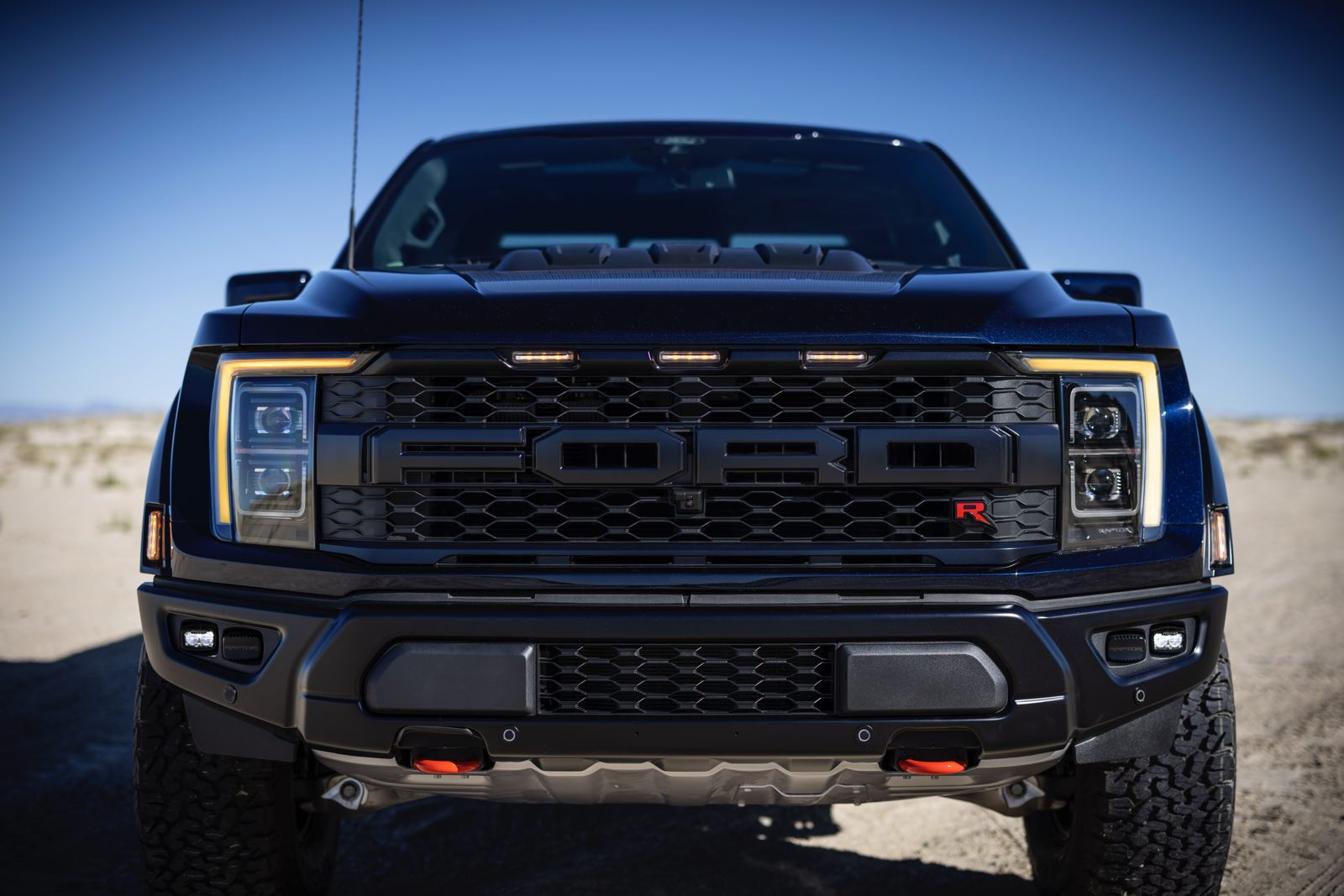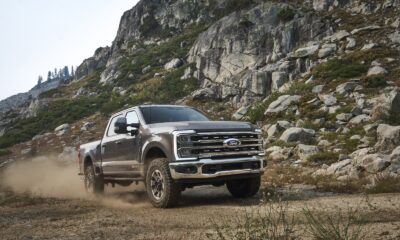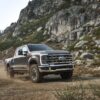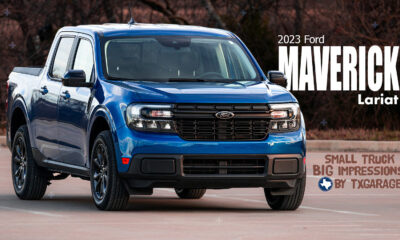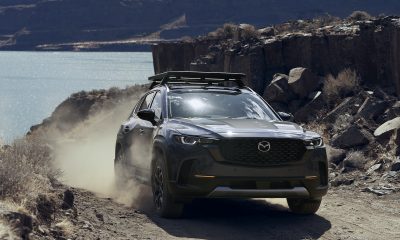Car Reviews
Ford’s F-150 Raptor R: MORE JURASSIC
Ford’s F-150 Raptor R:
MORE JURASSIC
Try as I might, I can’t get that grin off my face.
It started on a desolate stretch of highway when I first mashed the accelerator of the Ford F-150 Raptor R. Twin, four-inch exhaust mortars unleashed the thunder of a Shelby-powered, 5.2-liter, supercharged 700-hp V8.
Within seconds, 640 lb.-ft. of torque pounded my head into the seatback. A glance down revealed the digital speedometer shooting up like the altimeter on a Falcon 9 rocket while the truck snapped through 10 gears as quickly as cards in the hands of a seasoned blackjack dealer.
A hair over nine seconds later I had covered a quarter mile and – thank heavens – the Raptor R was running out of steam. Car and Driver says the truck’s top speed is around 114 mph. I didn’t have time to look.
That number seems low for that much horsepower, but it makes sense when you think about what Ford did when it heisted the heart of Shelby’s GT500® street demon and turned it into an off-road truck monster. Ford Performance recalibrated the supercharger and installed a new pulley to optimize power for off-road use, increasing torque at the low- to mid-range.
To maintain the extreme durability the Raptor brand is known for, Ford upgraded the exhaust manifolds to cast stainless steel, worked in a unique oil cooler and filter, and deepened the oil pan to ensure pickup while tackling aggressive grades. To help the engine breathe better, air intake volume was increased by 66% via a wider air intake inlet and through a higher-flow, higher-efficiency conical air filter.
Those are just a few of the reasons a Raptor R costs $30,500 more than a run-of-the-mill Raptor, which starts at $78,570. Are they worth it? Sure, if your wallet and conscience are OK with deplorable fuel consumption. Some relevant numbers:
Raptor R ($107,350 start)
- EPA fuel economy (city/highway/combined) 10/15/12.
- Annual fuel cost: $4,400
- Save or spend over 5 years (compared to an average of 28 mpg): SPEND $12,500
- Annual petroleum consumption: 24.8 barrels
- Grams CO2/mile (national average 233): 741
Raptor ($76,775 start)
- city/highway/combined: 15/18/16.
- Annual fuel cost: $3,300
- Save or spend over 5 years: SPEND $7,000
- Annual petroleum consumption: 18.6 barrels
- Grams CO2/mile (national average 233): 451
F-150 ($38,600 – $68,795 start)
- city/highway/combined 18/23/20.
- Annual fuel cost: $3,300
- Save or spend over 5 years: SPEND $3,750
- Annual petroleum consumption: 14.9 barrels
- Grams CO2/mile (national average 233): 451
We include CO2/mile data because polling indicates most Americans think there is nothing they can do about global warming; indeed, many blame China, where the per capita fuel consumption in the entire economy is less than one-fourth of that here. To be precise, 23.03%.
Personally, my carbon footprint responsibility begins and ends with one American. My SUV gets 29 mpg so I’m just an average guy. Beautiful Blonde Bride’s sedan gets 34, but her above-averageness is statistically significant in all things except her taste in men.
Otherwise, a great truck
Still, as one who first bloodied his knuckles under the hoods of muscle cars – OK, there was that one kid in middle school who wouldn’t stop with the “Baloney” thing – I can’t help falling in love with the Raptor. I’ve been a fan since it hit the streets in 2012.
Drawing its name from both the colloquial term for birds of prey as well as the Velociraptor, it is a street-legal counterpart of Ford’s off-road racing trophy truck. With upgraded suspensions, beefier chassis components, and refined drivelines, Raptors have proven to be competent dune racers and off-roaders while serving as comfortable and durable daily drivers.
Add in luxury cabins, mix in a heavy dose of Ford’s most advanced technology, and one has a machine that is simply a joy to drive, even at reasonable speeds.
Trail Turn Assist allows drivers to shrink their turning radius on tight turns and go even further off-road. Ford Trail Control™ – think cruise control for off-roading – lets drivers select a set speed and steer through challenging conditions while the truck handles throttle and braking. Trail 1-Pedal Drive allows customers to control throttle and braking with just one pedal to make extreme rock crawling easy.
I can flyyyy!
As the name implies, the Raptor was built to fly. In the truck world, that means soaring over Baja dunes, which requires special front and rear suspensions. In the back, instead of leaf springs are five-link coils over springs which serendipitously eliminates pickup bounciness.
In front are long-travel suspension arms.
The Raptor R gets even more goodies to help it fly.
The five-link rear suspension features extra-long trailing arms to better maintain axle position on rough terrain, a Panhard rod, and 24-inch coil springs – all optimized for outstanding stability while traversing desert terrain at high speeds.
Advanced FOX Live Valve shocks are tuned to balance ride quality and roll control on- and off-road. These electronically controlled dampers use suspension height sensors (and others) to monitor terrain conditions hundreds of times a second while adjusting suspension tuning accordingly. Wheel travel of 13 inches in front and 14.1 inches in back lets the truck traverse sand and rocks with terrific capability.
The effect is stunning. Flying down a potholed mountain road, the Raptor is like a duck crossing water. Underneath, it works like crazy, but the ride in the cabin is smooth. On the tarmac, the suspension gives the Raptor a ride more befitting a German salon sedan.
Power and prowess come at a price: fuel economy…or lack thereof. Ford addressed that with the second generation in 2017, dropping a 411-hp, 6.2-L V8 in favor of a 450-hp, twin-turbo, EcoBoost V6: more power, better fuel economy.
That would still be the only powerplant found in a regular Raptor had it not been for Ram, which in 2021 came out with the competing TRX (T-Rex, get it?), powered by a 703-hp, 6.2-L Hemi V8. That only seems to give Ram a huge advantage.
Ford, you may recall, pioneered the use of aluminum bodies in 2015. Though competitors now employ aluminum in important body parts, like hoods, tailgates, and doors, Ford continues to lead in this technology. On average, a Raptor weighs around 850 lbs. less than a TRX.
On the other hand, we are talking pickups, a manifest guy thing. I expect no argument when I posit that, to guys, size still matters.
Thus, who can blame Ford? According to Cox Automotive, the average gross profit on an F-150 is well over $15,000. Double that with the Raptor, and double it again with the Raptor R.
Yet, the Raptors are a high-value proposition. Because they are so strong, they are durable. At the same time, while Ford sells more than 650,000 F-150s a year, it builds only around 30,000 Raptors a year. On the used market, demand seems to outstrip supply and it is not at all unusual to see low-mileage used ones selling at or near what they cost on the showroom floor.
Ford insiders say the company will limit Raptor Rs to less than one-third of total production, so if you buy one and don’t drive it much, you’ll do just fine.
And save on gas, too.



